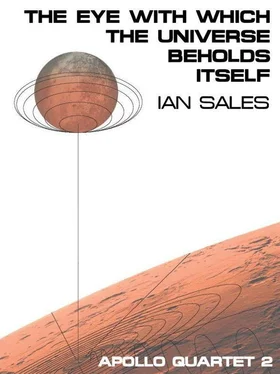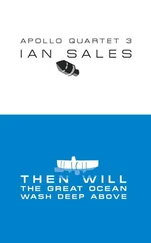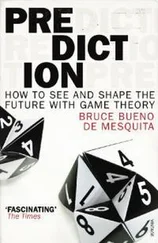He leaves the hammer and sampling scoop and crosses to the ramp up to the rim. Exhaustion limits his actions. He moves like an old man, he’s covered in a thin film of sweat and the LCG can’t keep him cool enough. If he stands still too long, he can feel sleep begin to steal upon him, and it takes an effort of will to remain awake and moving.
It takes him far too long to ascend out of the chamber, but eventually he makes it to the top, and he has to rest for twenty minutes. Once he has recovered, he makes his way slowly to the MRV and settles gratefully into its seat. He fastens the lap-belt, grabs the T-bar and pushes it forward. He’s tired, he’s not thinking straight. The MRV spins its wheels and then lurches forward. Too late, he thinks to pull the T-bar towards him. The front left wheel hits a rock, the entire vehicle bounces, and when it hits the ground, the wheel is bent out of true.
Elliott’s mind blanks. He sits there and gazes at the MRV’s broken wheel. This vehicle’s not going to move any further, and it’s a four mile hike back to the MM. For the first time since launching from the Cape, since arriving on Mars, he feels real fear. He puts the MRV in reverse and gently pushes the T-bar forward, but it’s not going to work, that bent wheel just jams against the chassis. Maybe he could fix it with the hammer, but he left the hammer down by the alien disc and he’s not sure he has the strength to go up and down that ramp again. Nor does he have the time to spare trying to fix the MRV.
He has to walk.
He clambers off the MRV and turns until he faces due north. He can’t see the MM, it’s over the horizon. He can’t even see the Face. Just a red desert of low dunes, scattered rocks, striped and scalloped hills in the distance blurred by a pink haze beneath a pastel sky. He’s used to the red now, it’s like his eyes are filtering it out and for one brief moment he sees an Earthly desert and he forgets he’s weighed down by an A7LB and PLSS. It’s almost as if he can feel a hot sun beating down on him and his mouth turns dry at the thought of it. There’s the track through the sand he made when he drove here. He just needs to follow that. He can do it, it’s only three and a half, maybe four, miles, he’s got three hours of air left in the PLSS.
He starts walking, but how it hurts. This spacesuit has no range of movement in the knee, it’s all in the hips and ankles. He’s used to it, but it’s hard work, the 0.367 G is no help, and after a week on Mars his muscles ache almost constantly. Soon he’s on autopilot, his mind drifts off somewhere, he moves his legs but he’s not conscious of doing so. His ankles are sore, his hips ache, his bruised hands pain him, it’s like he can feel his bones grating against one another. The MRV is now so far behind him now he can’t see it, he’s surrounded by lifeless desert and he shuffles through it like it’s the spacesuit doing the walking and not the man inside it.
The excitement of his discovery has gone, blown away, and he’s so weak now he doesn’t know if he can keep on moving. It’s like walking on fire with broken ankles and hips. The red sand is a bed of flames, he’s so hot he’s starting to boil, he’s walked so far he’s walked clean off Mars and into Hell. He’s not going to make it, he’s going to collapse in the sand, he’ll never make it to the MM. Tears run down his cheeks and he slides one foot forward and then the other. He closes his eyes and he can see Judy. She’s standing in front of the French windows and she glows with light like an angel. It’s the photograph he has back in the MM, it’s there in front of him, just out of reach. No, she is just out of reach, and she’s beckoning him to her. He roars through the pain, he can’t lift his arms to embrace her, but he stumbles on, drawn toward the presence of her, the light of her…
Elliott is in the cupola when the Robert H Goddard arrives at Gliese 876. The pearly shell which encloses the asteroid abruptly vanishes and the universe rushes in, a sudden blackness which leaves spots before his eyes. Then a river of stars spreads across the sky in an eyeblink as if thrown by some Jackson Pollock of the heavens.
Gliese 876 is a dim red furnace about two million miles distant. The Goddard rotates, and Gliese 876 d, Earth Two—Hell—rolls into view. It’s a huge world, three times the size of Earth, and it just plain looks hot. Beneath the crimson light of its sun, the land resembles a planet-spanning brushfire, the edges of hills and valleys limned in blood-red. He’s seen the PBS specials, but the one thing those shows can’t capture is the world’s sheer presence. There is nothing like it in the Solar System—it’s as barren as the Moon, but it has air and clouds and a climate. And that red light…
Up near the north pole, where Phaeton Base is located, they say it’s like a hot day in north Africa. Elliott is not convinced. Surface gravity is 1.5G—that and the red light is not going to feel like Africa to him. He’s been told he’ll get used to it.
He somersaults and dives down from the cupola. Another somersault as he approaches the deck, and he hits it with both feet and locks the triangular cleats on his shoes into the gridwork.
Finley is standing behind the pilot and flight engineer, one hand on the back of the pilot’s chair. His other hand he has up to one of the earpieces in his communications cap and he is talking slowly and clearly into his microphone, saying, Phaeton Base, this is the Robert H Goddard, please respond.
Elliott glances across at Stewart at the navigator’s station. No response? he asks.
We can’t even find the damn base on the remote telescope, Stewart replies. He grimaces. Can’t get the radio beacon either, he adds.
This is what Elliott was sent here to investigate. And it looks like Phaeton Base really has vanished. But if it has disappeared, where has it gone? And what caused the disappearance?
Later they gather round the galley table in the rec area. A pilot and flight engineer remain on duty in the command centre, but everyone else is here. It’s crowded. The table can only comfortably fit six, so the other six are scattered about the area at different heights and in different orientations. Elliott is at the table, shoes firmly cleated to the deck. He’s sort of in charge.
The base is not responding, Finley says, not on S-Band or VHF.
From four hundred miles up, the base should be visible. They keep it brightly-lit at all times—the dim red sunlight badly affects morale. There is also an extensive greenhouse, and that splash of green would certainly stand out against the relentless red of Earth Two’s surface.
I don’t get it, says one of the systems engineers, McKay.
You think maybe it’s aliens? asks Stewart. He looks pointedly at Elliott, and adds, That’s why they sent you, right? You’ve been to Area 51, you’ve seen aliens there. Right?
There are no aliens and no UFOs at Area 51, Elliott responds. He holds up a hand, and continues, But that doesn’t mean we can’t rule out an extraterrestrial cause here. We’re fifteen light years from Earth, after all.
That last fact means they’re on their own. There’s no way of communicating with Earth. A radio message would take fifteen years to reach home, assuming they had equipment powerful enough.
I have to go down there, Elliott says. Maybe there’s clues on the ground to what happened.
Too dangerous, replies Finley.
Dangerous? scoffs Elliott; It’s a dead world. Fifteen years we’ve had a base there and they’ve found zip.
Yeah, but now the base is gone. Maybe they did find something, maybe that’s what happened to the base.
All the more reason for me to go down there, insists Elliott.
Читать дальше












